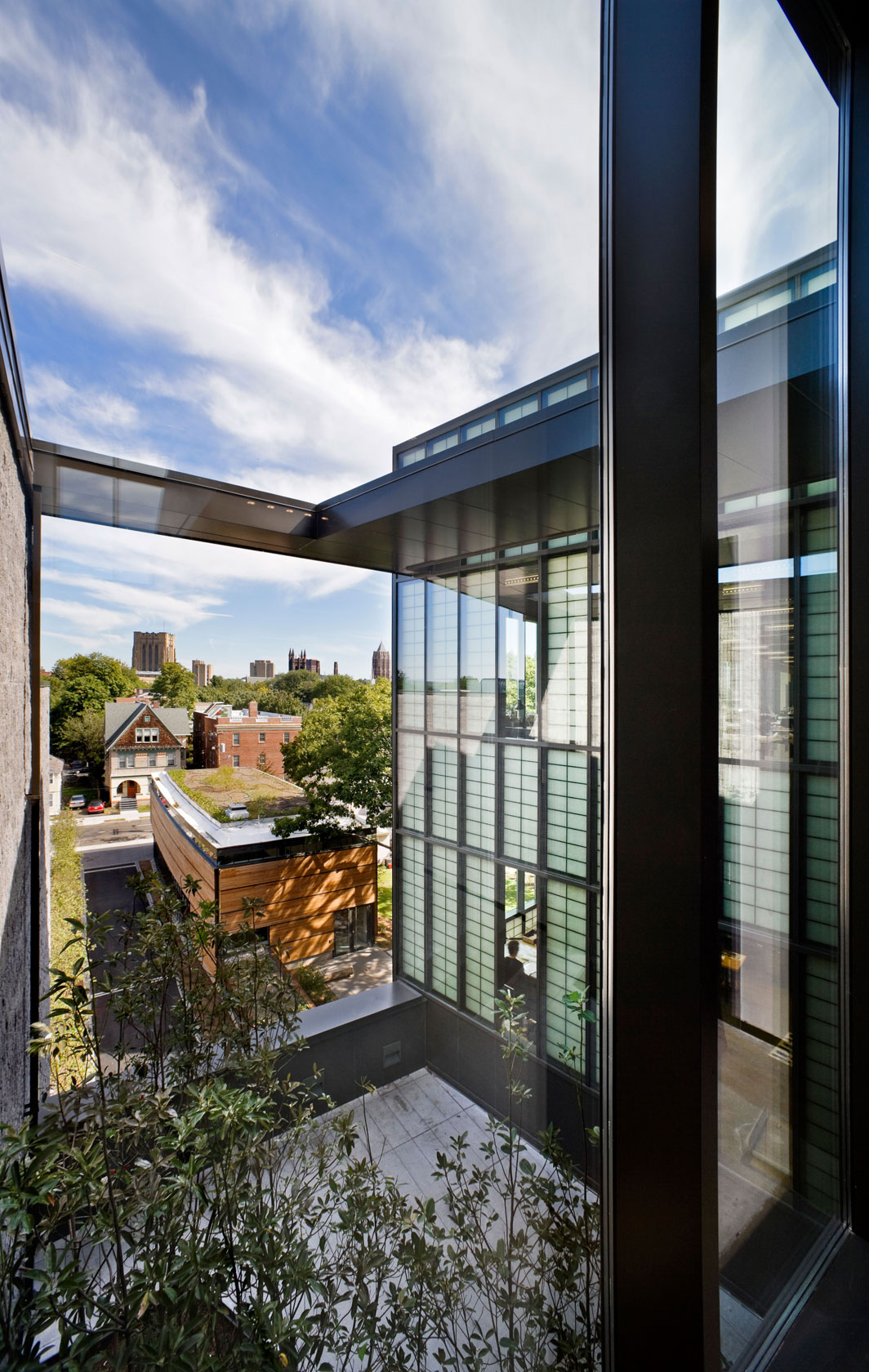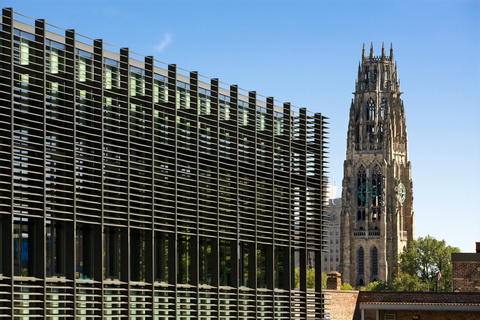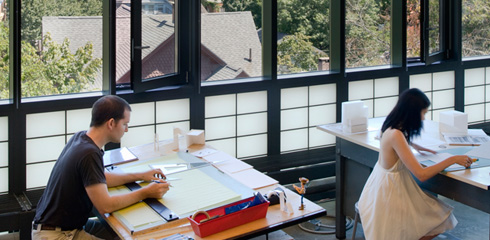Yale Achieves First LEED Platinum in Connecticut
This image shows a detail of the high-performance envelope of the sculpture building, with a view of the green roof atop the art gallery.
© Peter Aaron/OTTO
With the Yale Sculpture Building and School of Art Gallery, the client aspired to LEED Silver performance only. The Platinum award (which is the highest level of LEED certification) in this case arose from the integrated process, not from exceptional expenditure for additive systems. For several months at the outset, the entire design team met with the client weekly. Options were assessed with all team members present as we developed the program, site orientation, massing, landscape, structure and curtainwall. The result is an artful building that thoroughly integrates performance with form and urbanism.
sustainable features
- The project restores and extends the urban fabric by creating pedestrian pathways through the site while creating perimeter street frontage on what was formerly a derelict parking lot. At night, the Sculpture Building illuminates the block, creating a safe passage from the main campus to the residential area at the campus edge.
- Connectivity is further restored by the creation of safe bus stops and the provision of 6% of parking spaces for alternative fuel/carpool cars. A consolidated program for the School of Art eliminates the need for driving between campus buildings. Fifteen bicycle stalls, showers and changing rooms have been included in the basement of the Sculpture Building to enable and encourage bicycle commuting.
- A green roof on the gallery and native plant landscaping on the site serves as a connective habitat patch for the avian species moving through the urban corridor.
- The landscape addresses the urban heat island effect by reducing site energy consumption and lowering overall site ambient temperature, thereby encouraging flora and fauna to inhabit the site. The cooler site helps reduce energy loads on neighboring buildings and can serve as a precedent for future development.
- Contaminated soil was removed prior to construction to remediate the former brownfield site. Previously impervious surfaces have been replaced by a rain garden, porous asphalt, native plantings, and shade trees.
- The Sculpture Building features a high performance façade that incorporates solar shading, a triple glazed low-e vision panel, 8-foot high operable windows and a translucent double cavity spandrel panel. Consequently, the building has a high level of energy performance while remaining fully transparent. Testing suggests that the overall R value of the spandrel assembly is in excess of R 20 while maintaining 20% visible light transmittance.
- The Sculpture Building is oriented north/south to minimize eastern exposure and almost eliminate western exposure. Research was conducted to calculate the proper angle needed for the horizontal sunshades on the south and east facades to minimize solar gain and maximize day lighting.
- A large expanse of windows in each studio space provides 2% daylight factor levels, views of the surrounding environment, and operable windows to allow personal control over studio ventilation.
- Daylight dimming ballasts are installed all perimeter occupied spaces, which subtly respond to interior light levels, providing full workspace lighting when natural lighting falls below 30 footcandles. The first floor shop spaces have been outfitted with clerestory windows and non-dimmable ballasts to eliminate all distractions, as safety is paramount in these areas.
- To achieve superior indoor air quality, a displacement ventilation system introduces air at low velocities and at higher than usual supply temperatures for increased energy efficiency and improved thermal comfort. This is the first such system to be installed on the Yale campus.
- Workshops are equipped with comprehensive exhaust systems that adjust to the number of machines running, ensuring the removal of airborne irritants while preventing a constant exhaust that would waste energy. To ensure that hazardous materials are not introduced on the studio levels and re-circulated through the building, an air monitoring system has been installed. This sampling system can be used for routine monitoring and diagnostics in the event of an air quality problem.
- A comprehensive site and building water management approach yields an astonishing level of water savings. A storm water retention system collects rainfall from the roof of the Sculpture Building and surrounding landscape, where it undergoes ozone treatment for grey water use in the building. Using treated water for toilet flushing eliminates the demand for potable water used for sewage transfer, and the installation of waterless urinals, dual flush toilets, and low-flow lavatories drastically reduces the amount of water used on a daily basis.
- The building massing minimizes the need for cooling by taking advantage of self shading during the summer and reducing exterior surfaces that are exposed to intense solar heat gains. Operable windows allow the building to ventilate naturally in spring and fall, reducing fan loads and providing surplus ventilation, while connecting the building to its external environment.
- During construction, 92% of the total building waste was recycled. The project has a recycled content value of 25% of the total materials, including reclaimed cedar sunscreens on the gallery building. 42% of the total projects materials by cost were manufactured within 500 miles of the project site, and 93% of the total project's materials by cost were manufactured using raw materials harvested within 500 miles of the site. Collection and storage facilities have been provided for post-occupancy recycling.
- Open floor plans in the Sculpture Building make the most efficient net square foot to gross square foot building possible by eliminating corridors and mechanical spaces. It is conceived as a loft to remain flexible, and can be divided to suit the needs of the inhabitants over time.
- The grid of infrastructure is designed so that nothing needs to be moved if the interior is modified. The internal organization of the studio building corresponds to the 2.5 foot module of the curtain wall mullions, and the lighting fixtures are busSTRUT System, to allow for flexibility of fixture types to support the changing needs of users.







